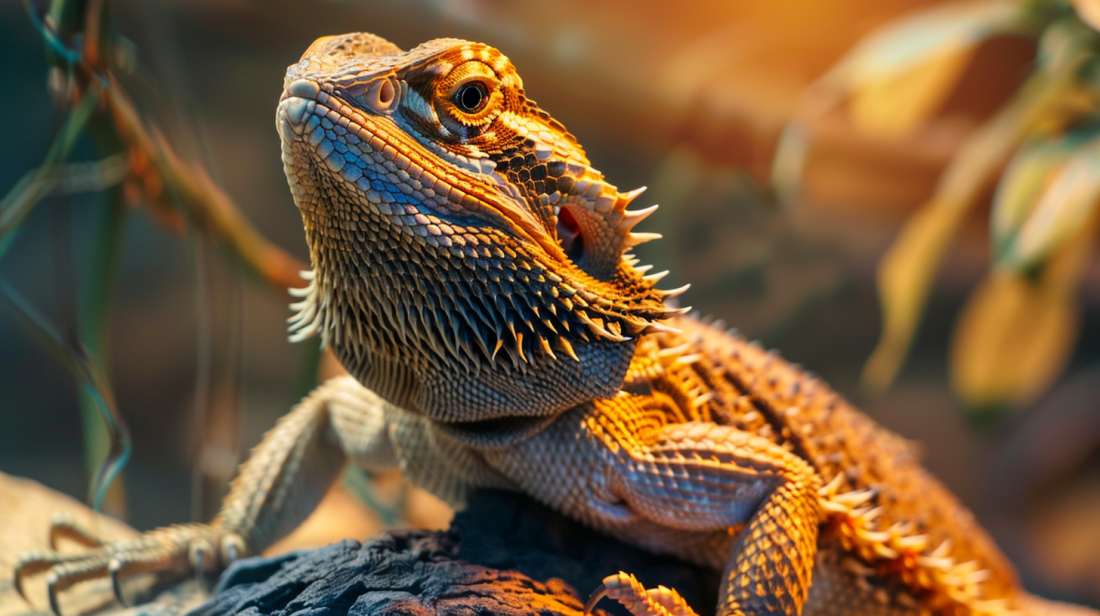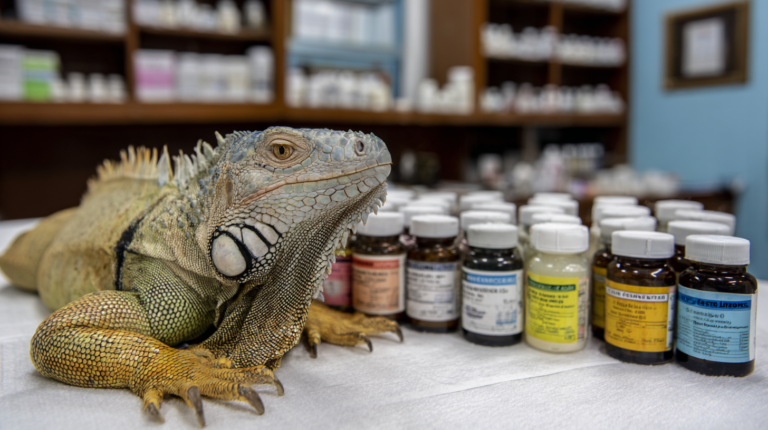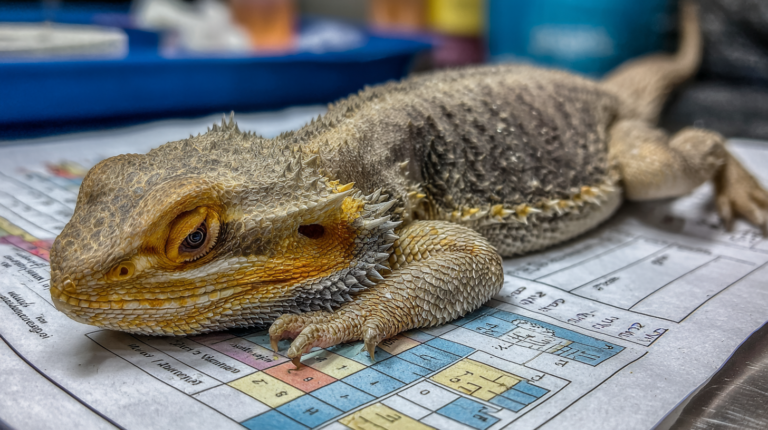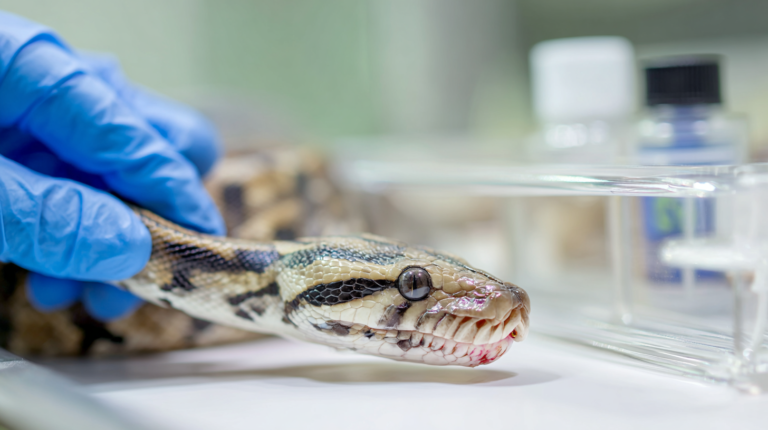Learn to identify 3 dangerous symptoms of intestinal worms in reptiles. Expert guide covers prevention, treatment, and when to seek veterinary care for your pet reptile.
Table of Contents
Reptile ownership brings unique joys and responsibilities, but one of the most concerning health issues that can affect your scaly companion is intestinal worms. Intestinal worms in reptiles represent a serious parasitic threat that can compromise your pet’s health, growth, and overall quality of life. Understanding the warning signs, prevention methods, and treatment options is crucial for every reptile owner who wants to ensure their pet’s long-term wellbeing.
Unlike mammals, reptiles often hide symptoms of illness until conditions become severe, making early detection of parasitic infections particularly challenging. This comprehensive guide will equip you with the knowledge to recognize the three most dangerous symptoms of intestinal worm infestations, understand the various types of parasites that can affect reptiles, and take appropriate action to protect your pet’s health.
Understanding Intestinal Worms in Reptiles
Intestinal parasites in reptiles encompass a diverse group of organisms that take up residence in your pet’s digestive system. Unlike mammals, reptiles have unique physiological characteristics that make them particularly susceptible to certain types of parasitic infections. Their slower metabolism, different immune responses, and specific digestive processes create an environment where parasites can thrive if conditions are favorable.
The most common types of intestinal worms affecting reptiles include:
Roundworms (Nematodes): These are among the most prevalent parasites in reptilian species. Roundworms can range from microscopic to several inches in length, depending on the species. They typically inhabit the small intestine and can cause significant damage to the intestinal lining.
Tapeworms (Cestodes): These segmented parasites attach to the intestinal wall and can grow to considerable lengths. They absorb nutrients directly from the host’s digestive system, leading to malnutrition and weight loss.
Hookworms: Particularly dangerous due to their blood-feeding behavior, hookworms attach to the intestinal wall and can cause severe anemia in infected reptiles.
Pinworms: While often considered less harmful than other parasites, pinworms can still cause irritation and discomfort, particularly in smaller reptile species.
| Parasite Type | Common Species | Affected Reptiles | Severity Level | Primary Symptoms |
|---|---|---|---|---|
| Roundworms (Nematodes) | Ascarids, Strongyloides | Bearded Dragons, Iguanas, Tortoises | High | Weight loss, diarrhea, visible worms in feces |
| Tapeworms (Cestodes) | Oochoristica, Cylindrotaenia | Snakes, Lizards, Geckos | Medium | Gradual weight loss, segments in feces |
| Hookworms | Kalicephalus, Strongyloides | Snakes, Monitor Lizards | High | Blood in stool, severe anemia, lethargy |
| Whipworms | Trichuris species | Tortoises, Large Lizards | Medium | Chronic diarrhea, mucus in stool |
| Pinworms (Oxyurids) | Pharyngodon, Thelandros | Tortoises, Iguanas | Low-Medium | Mild digestive upset, visible worms |
| Flukes (Trematodes) | Plagiorchis, Telorchis | Aquatic Turtles, Semi-aquatic Species | High | Liver damage, respiratory distress |
The Parasitic Lifecycle
Understanding how these parasites operate is essential for prevention and treatment. Most intestinal worms in reptiles follow a complex lifecycle that may involve intermediate hosts. For example, many tapeworms require arthropods as intermediate hosts before they can infect reptiles. This means that feeding wild-caught insects or poorly sourced food items can introduce parasites into your reptile’s system.
The lifecycle typically involves:
- Egg stage in the environment or intermediate host
- Larval development
- Ingestion by the reptile host
- Maturation in the digestive system
- Reproduction and egg laying
- Egg elimination through feces
This cycle can be disrupted through proper husbandry, quarantine procedures, and regular veterinary care.
The 3 Most Dangerous Symptoms to Watch For
1. Severe Weight Loss and Muscle Wasting
The first and most alarming symptom of intestinal worms in reptiles is rapid, unexplained weight loss accompanied by visible muscle wasting. This symptom is particularly dangerous because it indicates that the parasites are significantly impacting your reptile’s ability to absorb nutrients from food.
What to Look For:
- Visible hip bones or spine becoming prominent
- Loose, wrinkled skin
- Decreased body condition score
- Hollow appearance around the eyes
- Reduced tail thickness (in species where this is applicable)
Why It’s Dangerous: Weight loss in reptiles occurs more rapidly than in mammals due to their different metabolic rates and lower body fat percentages. A reptile can lose 20-30% of its body weight before owners notice significant changes, at which point the infection may be advanced. Dr. Sarah Mitchell, a reptile veterinarian with over 15 years of experience, notes that “reptiles mask illness very well as a survival mechanism, so by the time weight loss is visible, the parasitic load is usually substantial.”
Case Study: A 3-year-old ball python named Stella was brought to a veterinary clinic after her owner noticed she felt “lighter” during handling. Despite maintaining her normal feeding schedule, Stella had lost 15% of her body weight over six weeks. Fecal examination revealed a severe roundworm infection. After treatment with appropriate anthelmintics and supportive care, Stella required three months to return to her normal weight and body condition.
2. Chronic Diarrhea with Blood or Mucus
The second dangerous symptom involves changes in fecal consistency, particularly the presence of chronic diarrhea containing blood or excessive mucus. This symptom indicates significant damage to the intestinal lining and can lead to dangerous dehydration and electrolyte imbalances.
What to Look For:
- Watery or loose stools lasting more than a few days
- Visible blood streaks in feces
- Excessive mucus production
- Foul-smelling waste
- Increased frequency of defecation
- Straining during defecation
Why It’s Dangerous: Chronic diarrhea in reptiles can quickly lead to dehydration, which is particularly dangerous for these animals. Reptiles have a lower water turnover rate than mammals, but they also have less efficient kidneys for water conservation. Blood in the stool indicates intestinal damage, which can lead to secondary bacterial infections and sepsis. The presence of mucus suggests severe inflammation of the intestinal lining.
Statistical Insight: Research published in the Journal of Herpetological Medicine and Surgery found that reptiles with bloody diarrhea due to parasitic infections had a 40% higher mortality rate compared to those with parasites but normal stool consistency. This underscores the critical nature of this symptom.
3. Severe Lethargy and Behavioral Changes
The third dangerous symptom encompasses dramatic changes in behavior and activity levels. While reptiles naturally have periods of reduced activity, the lethargy associated with severe parasitic infections goes beyond normal behavioral patterns.
What to Look For:
- Extreme reluctance to move or inability to move normally
- Failure to respond to normal stimuli
- Inability to thermoregulate properly
- Lack of feeding response
- Unusual hiding behavior or remaining in one position for extended periods
- Weak or absent defensive responses
Why It’s Dangerous: Severe lethargy in reptiles often indicates systemic illness and can be a sign that the parasitic infection has progressed to a life-threatening stage. When reptiles become too weak to thermoregulate properly, their immune system becomes compromised, making them susceptible to secondary infections. The inability to feed or digest food properly creates a dangerous cycle where the reptile becomes weaker and less able to fight off the parasitic infection.
Expert Opinion: Dr. Michael Rodriguez, a specialist in exotic animal medicine, explains: “When we see severe lethargy in reptiles with parasitic infections, we’re often dealing with a compromised immune system and potential organ damage. This is typically a late-stage symptom that requires immediate intervention.”
Additional Warning Signs and Early Detection
Beyond the three most dangerous symptoms, several other signs can indicate the presence of intestinal worms in reptiles:
Physical Indicators
- Visible worms in feces or around the cloaca
- Abnormal swelling of the abdomen
- Regurgitation of food
- Excessive scratching or rubbing against objects
- Changes in skin color or texture
- Difficulty shedding (dysecdysis)
Behavioral Changes
- Increased aggression or irritability
- Changes in feeding behavior
- Altered basking patterns
- Restlessness or constant movement
- Excessive drinking or lack of interest in water
Digestive System Changes
- Vomiting or regurgitation
- Constipation alternating with diarrhea
- Abnormal fecal odor
- Presence of undigested food in feces
- Changes in appetite patterns
| Symptom Category | Specific Signs | Urgency Level | Typical Timeline | Action Required |
|---|---|---|---|---|
| Severe Weight Loss | Visible muscle wasting, prominent hip bones, sunken eyes, loose skin | Critical | 2-4 weeks | Immediate veterinary care within 24-48 hours |
| Chronic Bloody Diarrhea | Blood or mucus in stool, frequent loose stools, dehydration | Critical | 1-3 weeks | Emergency veterinary visit same day |
| Severe Lethargy | Inability to move normally, prolonged hiding, no response to stimuli | High | 1-2 weeks | Veterinary appointment within 2-3 days |
| Behavioral Changes | Loss of appetite, aggression, unusual positioning, reduced activity | High | 1-4 weeks | Schedule veterinary exam within 1 week |
| Visible Parasites | Worms in feces, around vent area, or vomited material | Moderate | Ongoing | Collect sample, vet visit within 5-7 days |
| Digestive Issues | Regurgitation, abnormal feces consistency, bloating | Moderate | 1-2 weeks | Monitor closely, vet visit within 1 week |
| Secondary Infections | Mouth rot, skin lesions, respiratory symptoms | High | 2-6 weeks | Comprehensive veterinary treatment needed |
Types of Intestinal Worms Commonly Found in Reptiles
Roundworms (Ascarids)
Roundworms are among the most common intestinal parasites in reptiles. These cylindrical worms can range from a few millimeters to several inches in length, depending on the species and host. They typically inhabit the small intestine and can cause significant damage to the intestinal lining.
Common Species:
- Ascaris species in snakes
- Toxocara species in lizards
- Ophidascaris species in various reptiles
Symptoms:
- Poor growth rates
- Intestinal blockages in severe cases
- Malnutrition despite adequate feeding
- Visible worms in feces
Tapeworms (Cestodes)
Tapeworms are segmented parasites that attach to the intestinal wall using specialized hooks and suckers. They can grow to considerable lengths and continuously shed segments containing eggs.
Transmission: Most tapeworms require intermediate hosts, such as insects, rodents, or other small animals. Reptiles become infected by consuming these intermediate hosts.
Symptoms:
- Segments visible in feces
- Chronic weight loss
- Malnutrition
- Intestinal irritation
Hookworms
Hookworms are particularly dangerous because they feed on blood from the intestinal wall. They attach using sharp teeth or cutting plates and can cause severe anemia in infected reptiles.
High-Risk Species:
- Bearded dragons
- Iguanas
- Monitor lizards
- Some snake species
Symptoms:
- Anemia (pale mucous membranes)
- Weakness
- Dark, tarry stools
- Stunted growth
Pinworms (Oxyurids)
Pinworms are small, thread-like parasites that primarily affect the large intestine and cecum. While often considered less harmful than other parasites, they can still cause problems in high numbers.
Symptoms:
- Anal irritation
- Restlessness
- Mild digestive upset
- Visible worms around the cloaca
Risk Factors and Prevention Strategies
Environmental Factors
The environment plays a crucial role in parasitic infections. Poor husbandry practices can create conditions that favor parasitic growth and transmission.
High-Risk Conditions:
- Overcrowding
- Poor sanitation
- Inadequate quarantine procedures
- Contaminated substrate
- Shared water sources
- Improper temperature and humidity levels
Dietary Factors
Food sources can be a significant vector for parasitic infections, particularly when feeding wild-caught prey items or poorly sourced commercial foods.
Risk Reduction Strategies:
- Source food from reputable suppliers
- Freeze prey items for at least 30 days before feeding
- Avoid feeding wild-caught insects or rodents
- Maintain proper food storage conditions
- Rotate food sources to prevent overexposure to specific parasites
Quarantine Protocols
Proper quarantine procedures are essential for preventing the introduction of parasites into established collections.
Recommended Quarantine Practices:
- Isolate new reptiles for a minimum of 90 days
- Conduct fecal examinations before introducing new animals
- Use separate tools and equipment for quarantined animals
- Maintain strict hygiene when handling different animals
- Monitor for symptoms throughout the quarantine period
Diagnosis and Veterinary Care
Fecal Examination Procedures
Accurate diagnosis of intestinal worms in reptiles requires professional fecal examination by a qualified veterinarian. This process involves several specialized techniques:
Direct Smear Examination: A small amount of fresh feces is mixed with saline solution and examined under a microscope. This method can detect motile parasites and some eggs.
Flotation Techniques: Fecal samples are mixed with solutions of specific gravity to float parasite eggs to the surface for collection and examination.
Sedimentation Methods: Some parasite eggs are too heavy to float and require sedimentation techniques for detection.
When to Seek Veterinary Care
Immediate veterinary attention is required if your reptile exhibits:
- Any combination of the three dangerous symptoms
- Visible worms in feces
- Sudden onset of severe symptoms
- Failure to respond to initial treatment
- Secondary complications such as respiratory distress
Treatment Protocols
Treatment of intestinal worms in reptiles requires professional veterinary supervision. Common anthelmintic medications include:
Fenbendazole:
- Effective against roundworms and some tapeworms
- Requires multiple doses
- Generally well-tolerated
Metronidazole:
- Effective against certain parasites and secondary bacterial infections
- Requires careful dosing
- May cause side effects in some species
Ivermectin:
- Effective against various parasites
- Requires precise dosing
- Contraindicated in some species
Supporting Recovery
Recovery from parasitic infections requires comprehensive supportive care:
Nutritional Support:
- High-quality, easily digestible foods
- Vitamin supplementation
- Probiotics to restore gut health
- Frequent, small meals
Environmental Management:
- Optimal temperature and humidity
- Stress reduction
- Enhanced sanitation
- Comfortable hiding places
Long-Term Health Implications
Immune System Effects
Chronic parasitic infections can have lasting effects on a reptile’s immune system. The constant stress of fighting parasites can lead to immunosuppression, making the animal more susceptible to other infections and diseases.
Organ Damage
Severe parasitic infections can cause permanent damage to various organs:
Liver Damage: Some parasites migrate through the liver, causing scarring and impaired function.
Intestinal Damage: Chronic inflammation can lead to permanent changes in intestinal structure and function.
Kidney Effects: Dehydration and toxin buildup can affect kidney function.
Growth and Development
Young reptiles are particularly vulnerable to the effects of parasitic infections, which can result in:
- Stunted growth
- Developmental abnormalities
- Reduced lifespan
- Compromised reproductive ability
Prevention Through Proper Husbandry
Habitat Management
Creating an environment that discourages parasitic infections is crucial for long-term health:
Substrate Selection:
- Use appropriate substrates that can be easily cleaned
- Avoid substrates that retain moisture and bacteria
- Replace substrate regularly
- Spot-clean immediately after defecation
Water Management:
- Provide clean, fresh water daily
- Use appropriate water containers
- Maintain proper humidity levels
- Avoid stagnant water sources
Feeding Practices
Proper feeding practices can significantly reduce the risk of parasitic infections:
Prey Selection:
- Choose captive-bred prey items when possible
- Quarantine new food sources
- Avoid feeding wild-caught prey
- Maintain proper prey storage conditions
Feeding Schedules:
- Establish regular feeding schedules
- Remove uneaten food promptly
- Monitor food intake closely
- Adjust feeding based on seasonal changes
Regular Health Monitoring
Proactive health monitoring can catch parasitic infections early:
Visual Examinations:
- Conduct regular visual health checks
- Monitor weight and body condition
- Observe feeding behavior
- Check for changes in activity levels
Fecal Monitoring:
- Collect fresh fecal samples for examination
- Schedule regular veterinary check-ups
- Document any changes in fecal consistency
- Maintain health records
Species-Specific Considerations
Snakes
Snakes are particularly susceptible to certain types of intestinal parasites due to their feeding habits and digestive physiology:
Common Parasites:
- Roundworms (Ophidascaris species)
- Tapeworms from rodent prey
- Hookworms in some species
Prevention Strategies:
- Freeze prey items for at least 30 days
- Source prey from reputable suppliers
- Maintain proper enclosure temperatures
- Provide appropriate hiding places
Lizards
Lizards face unique challenges with parasitic infections, particularly species that consume insects:
High-Risk Species:
- Bearded dragons
- Iguanas
- Geckos
- Monitor lizards
Prevention Approaches:
- Gut-load insects properly
- Vary insect species in diet
- Maintain proper UVB lighting
- Provide adequate basking opportunities
Turtles and Tortoises
Aquatic and semi-aquatic species face additional risks from water-borne parasites:
Water Quality Management:
- Maintain proper filtration systems
- Perform regular water changes
- Monitor water parameters
- Provide appropriate basking areas
Dietary Considerations:
- Avoid feeding wild-caught fish
- Provide varied, balanced diets
- Monitor for signs of nutritional deficiencies
- Consider seasonal feeding adjustments
| Treatment Phase | Duration | Procedures & Tests | Expected Outcomes | Estimated Cost Range |
|---|---|---|---|---|
| Initial Diagnosis | 1-3 days |
|
Identification of parasite species, assessment of infection severity | $75 – $150 |
| Treatment Planning | 1-2 days |
|
Customized treatment protocol, owner education | $50 – $100 |
| Active Treatment | 2-8 weeks |
|
Parasite elimination, symptom improvement, weight stabilization | $200 – $500 |
| Mid-Treatment Assessment | 1 week |
|
Treatment efficacy confirmation, protocol adjustments | $100 – $200 |
| Final Treatment Phase | 2-4 weeks |
|
Complete parasite clearance, health restoration | $150 – $350 |
| Post-Treatment Monitoring | 3-6 months |
|
Sustained parasite-free status, long-term health maintenance | $200 – $400 |
| Emergency Intervention | 1-7 days |
|
Life-saving intervention, stabilization of critical condition | $500 – $1500+ |
Creating a Parasite Prevention Plan
Assessment and Planning
Developing a comprehensive parasite prevention plan requires careful assessment of your reptile’s specific needs:
Risk Assessment:
- Evaluate species-specific risks
- Consider environmental factors
- Assess feeding practices
- Review husbandry protocols
Prevention Timeline:
- Establish quarantine periods
- Schedule regular veterinary check-ups
- Plan routine fecal examinations
- Create monitoring schedules
Implementation Strategies
Successful parasite prevention requires consistent implementation of best practices:
Daily Practices:
- Maintain proper temperatures and humidity
- Provide clean water and appropriate food
- Monitor behavior and appetite
- Maintain enclosure cleanliness
Weekly Practices:
- Deep clean enclosures
- Replace substrate as needed
- Check equipment function
- Document health observations
Monthly Practices:
- Conduct thorough health examinations
- Review and update husbandry protocols
- Assess nutritional needs
- Plan veterinary consultations
Monitoring and Adjustment
Effective parasite prevention requires ongoing monitoring and adjustment:
Health Tracking:
- Maintain detailed health records
- Document any changes in behavior or appetite
- Track growth and development
- Monitor treatment responses
Protocol Updates:
- Adjust practices based on new information
- Incorporate veterinary recommendations
- Update protocols for seasonal changes
- Revise approaches based on effectiveness
Emergency Response and Crisis Management
Recognizing Emergencies
Knowing when a parasitic infection has become a medical emergency can save your reptile’s life:
Emergency Indicators:
- Inability to move or respond to stimuli
- Severe dehydration
- Visible distress or pain
- Rapid deterioration in condition
- Failure to respond to initial treatment
Immediate Actions
When faced with a parasitic emergency:
First Aid Measures:
- Ensure proper temperature and humidity
- Provide supportive care
- Document all symptoms
- Prepare for veterinary transport
Veterinary Communication:
- Call ahead to the veterinary clinic
- Provide detailed symptom history
- Bring recent fecal samples if available
- Prepare for immediate treatment
Post-Crisis Management
Recovery from severe parasitic infections requires ongoing management:
Monitoring Requirements:
- Increased observation frequency
- Regular weight checks
- Dietary adjustments
- Environmental modifications
Follow-up Care:
- Complete prescribed treatment courses
- Schedule follow-up examinations
- Conduct repeat fecal examinations
- Adjust long-term care protocols
For more expert pet care tips and product recommendations, visit BlithePet.com — your trusted source for pet wellness.
Frequently Asked Questions
Everything you need to know about intestinal worms in reptiles
Healthy adult reptiles should have fecal examinations at least once annually during routine veterinary check-ups. However, new reptiles, young animals, or those with previous parasite issues may require more frequent testing every 3-6 months. If you notice any symptoms or behavioral changes, immediate fecal examination is recommended.
While most reptilian parasites are species-specific, some can potentially affect humans, particularly immunocompromised individuals. Always practice good hygiene when handling reptiles and their waste, including washing hands thoroughly after contact and avoiding contact with feces. If you have concerns about zoonotic transmission, consult both your reptile’s veterinarian and your personal physician.
Yes, it’s extremely common for wild-caught reptiles to harbor various parasites, with infection rates often exceeding 80%. This is why proper quarantine and immediate veterinary examination are crucial for wild-caught animals. Even if parasites are present, they can often be successfully treated with appropriate veterinary care.
No, never attempt to treat parasitic infections with over-the-counter medications or home remedies. Reptile parasites require species-specific treatments that must be prescribed and monitored by a qualified veterinarian. Incorrect treatment can be dangerous and potentially fatal to your reptile.
Treatment duration varies depending on the type of parasite, severity of infection, and the reptile’s overall health. Simple infections may resolve within 2-4 weeks, while more complex cases can require several months of treatment. Follow-up fecal examinations are essential to confirm successful treatment.
Yes, some species are more vulnerable due to their natural diet, habitat, and physiological characteristics. Insectivorous species like bearded dragons and geckos may be at higher risk due to their varied diet, while some snake species are susceptible to specific parasites from their prey. Your veterinarian can provide species-specific guidance for prevention and monitoring.
No questions found matching your search.
Conclusion
Intestinal worms in reptiles represent a serious health concern that requires vigilant monitoring, proper prevention, and prompt veterinary intervention when symptoms appear. The three dangerous symptoms we’ve discussed—severe weight loss and muscle wasting, chronic diarrhea with blood or mucus, and severe lethargy with behavioral changes—serve as critical warning signs that should never be ignored.
Understanding these symptoms, implementing comprehensive prevention strategies, and maintaining regular veterinary care are essential components of responsible reptile ownership. Remember that early detection and treatment significantly improve outcomes, while neglecting these signs can lead to severe complications or loss of your beloved pet.
By following proper husbandry practices, maintaining clean environments, sourcing food from reputable suppliers, and establishing regular health monitoring routines, you can significantly reduce the risk of parasitic infections in your reptile companions. When in doubt, always consult with a qualified veterinarian who specializes in reptile medicine.
The investment in preventive care and early intervention far outweighs the costs and heartbreak associated with advanced parasitic infections. Your reptile depends on you to recognize these warning signs and take appropriate action to protect their health and well-being.
Have a similar experience with your pet? Share it in the comments below!





